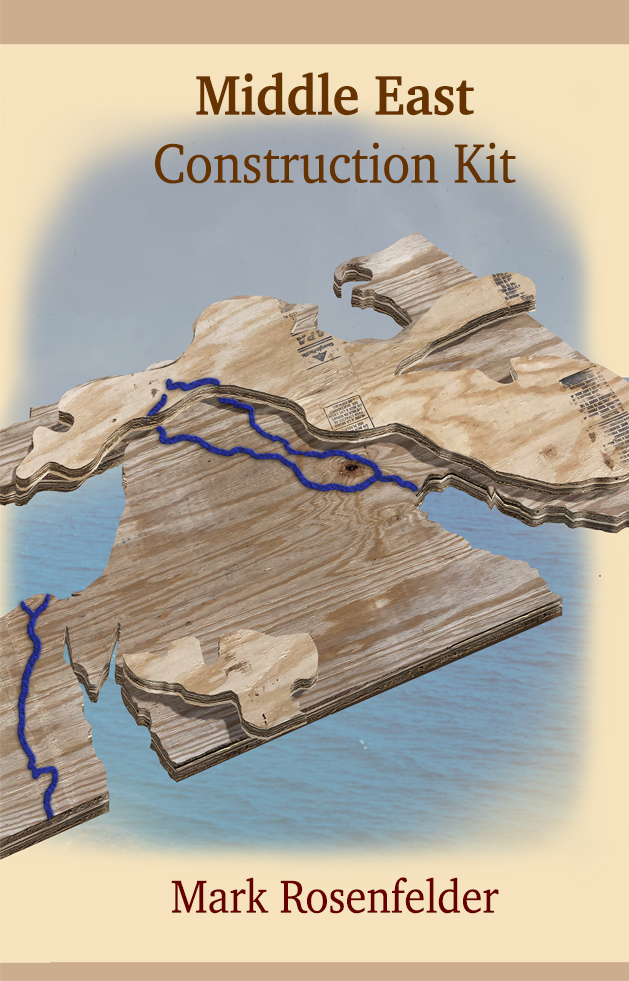Middle East Construction Kit

by Mark Rosenfelder
Go back four thousand years, and most of the planet was civilization-free. The Chinese weren’t reading oracle bones yet; the Rigveda was in the future; it was a millennium before the Hebrew kingdoms and a millennium and a half before the rise of Greece.
Yet the Middle East was already old. The Sumerians had begun writing 1200 years before; the pyramids were 600 years old— Egypt was in its Middle Kingdom.
This book is about these oldest of civilizations: Sumer, Babylonia, Assyria, Egypt, and where they met and fought, Canaan/Israel. It covers the period from Homo erectus to Alexander.
How does this book differ from other introductions?
There are some excellent books on the ancient Middle East for general readers (see the bibliography!). What’s different about this one?- Most researchers learn Akkadian and/or Egyptian— then, as much as possible, have to keep the language stuff out of their books. I expect my readers are interested in language, so I’ve covered language in depth.
- Most popular books focus on one region: Egypt, or Israel, or Mesopotamia. But these cultures were constantly fighting and interacting, and a broader canvas is more informative.
- Some classic works are a little old-fashioned in their assumption that civilization is always progress. But it’s a very interesting question whether this is so. Why did hunter-gatherers tie themselves down in fixed settlements? Why did egalitarian people submit to absolute monarchs? Were people better or worse off in the frequent “dark ages” between major dynasties?
Who is it for?
- Anyone who wants to know more about the ancient Middle East.
- Conworlders who want to know more about how agriculture, kingship, cities, writing, and religion developed.
- Conlangers interested in ancient languages. You know you really wanted to base something on Sumerian.
- People interested in the historical and cultural background of the Tanakh (the “Old Testament”).
What’s covered?
- An overview introducing the region, geography, climate, and languages; also considers how we know about history and what we don’t know.
- A survey of literature from Egypt, Mesopotamia, Israel, and Canaan.
- A history of the region, up till the Greek conquest.
- Chapters on culture, clothing, technology, and everyday life, in Mesopotamia and Egypt.
- Overviews of Egyptian and Mesopotamian polytheism, of Zoroastrianism (the religion of ancient Persia), and of Judaism (the latter concentrating on the considerable number of things Christians don’t know).
- A chapter on conworlding: how to use all this information to create a fantasy culture that’s not the Standard Medieval European Kingdom, with an emphasis on thinking about origins.
- Meaty grammatical sketches of Sumerian, Akkadian, and Hebrew.



Did you know...?
Fun facts to know and tell from Middle East Construction Kit :- The first poet in history whose name we know is a woman, Enḫeduana. She was the daughter of king Sargon of Akkad, and made high priestess of Inanna in the 2300s BCE. One of her surviving poems is a lament over being driven from office by the next king.
- Her position wasn’t unusual: both Mesopotamians and Egyptian kings gave their daughters high positions. They could effectively represent the king, and they were safer than powerful sons.
- In the first historical epic, Gilgamesh, the hero defeats several monsters— against the advice of his mother and the gods— but fails in his main goal and simply returns home.
- Judaism did not introduce the idea of social justice— we have eloquent works from both Egypt and Mespotamia complaining of the treatment of poor and the callousness of the rich. We also have Mespotamian works which, like Job, question the benignity of the gods.
- Similarly, the Biblical flood story is retelling of a Mesopotamian myth, in which Enlil wishes to destroy humans— because they are too noisy— but Enki tells one Atraḫasis to save himself and his family with a ship. Even the Biblical detail of sending out a bird to find dry land comes from the story of Atraḫasis.
- Queens were often powerful in Egypt’s Middle Kingdom, but one queen was a king— Hatshepsut, who was a regent for her stepson, but took power as a king herself. For ritual reasons she was depicted with a male kilt and a king’s rather than a queen’s crown, and in some illustrations she was drawn as a man.
- Though civilization also created debt and slavery, the Mesopotamian kings would periodically forgive all debts and free slaves. The Jubilee is the Tanakh’s version of this.
- Scribes were valuable: a herblorist sent by the king of Babylon to the Hittites married into the Hittite royal family.
- Greek astronomers used Babylonian astronomical observations to predict eclipses— and the observations have also been used by modern astronomers to confirm the lengthening of the day.
- A tomb in Egypt contains a gay couple, Khnumhotep and Niankhkhnum— the first in history whose names we know.
- To build the Pyramids, workers would have had to place a one-ton stone once every two minutes. You don’t need aliens for this, but you do need a wide ramp.
- Somewhat disappointingly, both the pyramids and the ziggurats were solid. (Khufu’s has a relatively small room inside, but making it was difficult and later pyramid builders were content to place their tombs underneath the structure.)
- A pagan asked the Jewish sage Šammai to teach him the entire Law while standing on one foot. Šammai drove him off with a builder’s tool. The pagan then asked Hillel, who accepted the challenge— see the book for his answer.
Any questions?
- Didn’t I learn all this in school?
- In part, probably, but you probably didn’t get the whole story. These civs were a lot more interesting than you may remember!
- Didn’t I learn all this in the Bible?
- The Tanakh is a highly valuable text, but it can’t be taken as literal history— not least because it is not completely consistent, but also because it doesn’t always fit what we know from archeology or other regions’ literature. Its component books were written at particular times, for particular purposes— then reinterpreted as sacred literature. We can learn a lot about ancient times from the Bible; but we can also learn a lot about the Bible from everything else we know about ancient times.
- When is it available?
- It’s available now! Go treat yourself, don’t you deserve it?
- How much is it?
- The price is $15.95 for the print softcover (but Amazon often offers discounts), $6.25 Kindle.
- How long is it?
- 392 pages, or in the metric system, 89.6 meters.
- For some reason I want a hardcover copy!
- You’re in luck! Amazon is offering this now, and we’ll try it out. The price is $27.95.
- What areas aren’t covered?
- There wasn’t time or room to give full coverage to Anatolia or the Caucasus. I would have liked to say a lot more about pre-imperial Iran, but too little is known.
I’ve purposely cut off the story with Alexander, because the Middle East then becomes— as it remained till modern times— just a part, though an important part, of a succession of empires. Plus the book would have had to be twice as long or else half as informative.
- I’m a little intimidated by all the unfamiliar names.
- I know, I know. And the Akkadians didn’t exactly help, naming themselves things like Abi-enši-Marduk. Maybe it helps to know that most of those names are actually sentences— this one mean “Marduk is the father of the weak.” Look, don’t expect to memorize the names, it’ll be fine.
- Do you have this sort of thing for other civilizations?
- Glad you asked! Check out the China Construction Kit and India Construction Kit .
